Problem Chosen
2021
Team Control Number
A
MCM/ICM
Summary Sheet
2113656
Fungus: Who Moved My Woody Fibers
Summary
The carbon cycle includes the decomposition of plant material and woody fibers. In nature,
fungi are the main decomposers. The decomposition rate of fungi is determined by two traits: the
growth rate of the fungus and their tolerance to moisture. In this paper, our goal is to model the
decomposition of woody fibers and analyze the interactions between different species.
In view of a single type of fungus living in America, firstly, we use the exponential decay
model to describe the decomposition process. Then we fit the experimental data related to growth
rate and moisture resistance to obtain the function between the decomposition rate and these two
traits. Finally, we establish the decomposition model of a single species of fungus. Taking five
types of fungi as examples, we get their decomposition processes respectively shown in Figure 6.
In view of various types of fungi living in America, we analyzed the short-term and
long-term trends respectively. In a short period of time, various species grow independently.
The total average decomposition rate is the sum of each. Then we establish the decomposition
model of various species in short-term. The simulated decomposition process is shown in Figure
7. In a long period of time, the species will influence on each other. We improved the Logistics
differential equation model and established a competition model of various species. After using
the Runge-Kutta method, we get their succession and decomposition process with interactions
shown in Figures 8 and 9.
Based on the above two models, we consider the impact of global warming and climate
conditions changes on the model. First, according to the time series ARIMA (0,1,1), we predict
the future annual average temperature in America. Compared with 2020, temperature conditions
in 2060 will cause the extinction of three species (Figure 13). Next, we bring the environmental
conditions of five representative climates into the competition model. Results show different
climates lead to different endings of competition (Figure 15).
Using the above two models, we find that as the number of fungal species increases, the
overall decomposition efficiency of ground litter continues to increase. And we analyze that
biodiversity plays a huge role in maintaining system stability.
Keywords: Fungus The carbon cycle Biodiversity of fungi The decomposition model
The Competition model of various species Differential equation
�
Team#2113656
Page 2 of 25
Contents
1 Introduction ............................................................................................................................... 3
1.1 Background ..................................................................................................................... 3
1.2 Restatement of the Problem ............................................................................................ 3
2 Analysis of the Problem ............................................................................................................ 4
3 Assumptions .............................................................................................................................. 5
4 Symbols..................................................................................................................................... 6
5 The Decomposition Process of Fungi ....................................................................................... 6
5.1 The Decomposition Model of Single Species ................................................................. 7
5.2 The Decomposition Model of Various Species ............................................................... 9
5.3 Simulations Based on The Decomposition Model ........................................................ 10
6 The Interactions Between the Various Species of Fungi..........................................................11
6.1 The Competition Model of Various Species ..................................................................11
6.2 Solutions of The Competition Model ........................................................................... 13
6.3 Sensitivity to Environmental Fluctuations .................................................................... 15
7 The Impact of Biodiversity ..................................................................................................... 18
7.1 The Impact on Decomposition Efficiency .................................................................... 18
7.2 The Importance and Role of Biodiversity ................................................................... 19
8 Model Test............................................................................................................................... 20
8.1 Analysis of Sensitivity .................................................................................................. 20
8.2 Analysis of Robustness ............................................................................................... 20
9 Strengths and Weaknesses ...................................................................................................... 21
9.1 Strengths ....................................................................................................................... 21
9.2 Weaknesses ................................................................................................................... 22
10 An Article for Fungi .............................................................................................................. 23
11 References ............................................................................................................................. 25
�
Team#2113656
Page 3 of 25
1 Introduction
1.1 Background
The carbon cycle is an important part of life on earth. It describes the process of the
exchange of carbon throughout the geochemical cycle of the earth and it maintains the balance of
carbon dioxide in the atmosphere. Part of the carbon cycle includes the decomposition of
compounds, and the key components of this part are the decomposition of plant materials and
woody fibers. In nature, the key component in decomposing woody fibers are fungi. We know
that the decomposition rate of woody fibers is determined by various traits of fungi through the
background of the research. In this problem, we would focus on just two traits of the fugus: the
growth rate and its tolerance to moisture.
Figure 1: The process of carbon cycle
1.2 Restatement of the Problem
Our main goals are to study the effect of the growth rate of the fungus and the fungus’
tolerance to moisture on decomposition rate, and to build a model about the decomposition of
woody fibers on a given land. For this, we need to solve the following problems:
⚫ Build a mathematical model to describe the specific decomposition process of litter and
wood fiber through fungal activity.
⚫
In the above model, when there are many different species of fungi, which have different
growth rates and different moisture resistance, we need to incorporate the interactions
between different species of fungi.
⚫ On the basis of the above, we need to build the model which describes the interaction
�
Team#2113656
Page 4 of 25
between different types of fungi, and the different performance of the dynamic
characteristics of the interaction in short-term and long-term trends should be characterized
and described. When the environment fluctuates rapidly, we need to test the sensitivity of the
model and determine the overall impact of changing atmospheric trends, so as to assess the
impact of local weather changes on the model.
⚫ We need to predict the relative advantages and disadvantages for each species and
combinations of species that may last for a period of time, and do so for the different
environments of arid, semi-arid, temperate, arbor, and tropical rainforest.
⚫ Analyze how the diversity of fungal communities of a system affects the overall efficiency
of ground waste decomposition. When there are varying degrees of changes in the local
environment, predict the importance and role of biodiversity.
⚫ By establishing and solving above models, we need to write a two-page article to discuss the
latest progress in our understanding of the role of fungi play in ecosystems.
2 Analysis of the Problem
⚫ Based on the Mitscherlich equation, we build a litter attenuation model conforming to the
negative exponential form. From the figures of the paper, we believe that the average
decomposition rate of the plant material and woody fibers is affected by the growth rate and
moisture resistance of the fungus (fungi). We fit this set of experimental data with a power
function and an exponential function, and found the equivalence relation between the growth
rate, the moisture resistance and average decomposition rate. Based on this, we show the
change of remaining proportion over time (single species) (Figure 6).
⚫ When a variety of fungi gather together, there is interactions between them, which is mainly
competition. We divide the decomposition process of various species into short-term and
long-term. In a short period of time, we believe that each fungus decomposes litter
independently, when the decomposition of litter by multiple groups can be considered as the
sum of individual’s. Taking five groups as an example, we show the change of remaining
proportion (various species, short-term trends) (Figure 7).
⚫ Over a long period of time, the result of fungal competition can be measured by the steady
state of the extension length of the hyphae. Based on the Logistics model and the
Lotka-Volterr model, we establish a competition model of various species, and measure the
contribution of different fungi
in decomposition with
the steady-state dominant
species-inferior species (Figure 8), and show the above five the change of remaining
proportion with competitions (various species, long-term trends) (Figure 9).
�
Team#2113656
Page 5 of 25
⚫ Since the external environment will determine the succession of the community, we
separately consider the impact of global warming and climate change on the model.
According to the time series ARIMA(0,1,1), we predict the annual average temperature of
North America in 2060 (Figure 12), which is 1.2℃ higher than 2020. We find that such a
small temperature change will cause three of the five species perish (Figure 13). Under the
different environments including arid, semi-arid, temperate, arboreal, and tropical rain
forests, the competition results of populations vary (Figure 15).
⚫ Considering the fungus and different combinations of fungi, we find that when the extension
length increases, the overall efficiency of ground garbage decomposition continues to
increase (Table 4). As for single fungus, environment change may cause the growth rate
greatly reduced, which hinder decomposition. But as for multiple groups, even if
environment change result in different results in the steady state of competition, the
decomposition rate is impacted little.
Figure 2: Problem solving ideas
3 Assumptions
⚫ In a short period of time, there is no interaction between different species of fungi
living in the same environment. In the early stages of growth, for all kinds of species,
resources such as nutrients, space, and dissolved oxygen are sufficient. Therefore, in the
short term, the adverse effects from other species on the growth of fungi can be ignored.
⚫ The interaction between different species of fungi is only equal to the competitive
relationship. When different types of fungi live in the same environment, there are complex
interrelationships between them, such as competition, cooperation, symbiosis and so on, but
competition is the most important and common relationship, so we can ignore other types of
�
Team#2113656
Page 6 of 25
interrelationships [1].
⚫ The data used in this article are true and credible. In order to apply and solve the
mathematical model which have been established, we collected the relevant data of 34 kinds
of fungi[2]. To ensure the objectivity and accuracy of the results, we make this assumption.
4 Symbols
Descriptions
Definitions
Mass of the material at time
Hyphal extension rate
Moisture resistance
Temperature
Humidity
Average decomposition rate
5 The Decomposition Process of Fungi
According to the relevant research, it is known that certain traits of fungi determine the
decomposition rate of plant materials and woody fibers.
Figure 3: The decomposition process of fungi
ttmvwTSk�
Team#2113656
Page 7 of 25
In this problem, we only need to focus on two traits of fungi: fungal growth rate (Hyphal
Extension Rate) and moisture resistance (the difference between a fungus’ competitive ranking
and its moisture niche width), and we assume these two traits are independent of each other. In
view of the existence of a single type of fungus or multiple types of fungi on a given land, we
have established a short-term decomposition model of fungus as follows:
5.1 The Decomposition Model of Single Species
According to the information in the title, when the ambient temperature is 22℃, the
relationship between mycelial extension rate and decomposition rate is shown in Figure 1, and
the relationship between moisture resistance and decomposition rate is shown in Figure 2:
Figure 4: The relationship between the hyphal Figure 5: The relationship between the moisture
extension rate (mm/day) of various fungi and (both scaled to [0,1]) of various fungi and the
the decomposition rate (% mass loss over 122 wood decomposition rate (% mass loss over 122
days at 22℃) days at 22℃, log transformed)
Since Figure 2 is the test result under the optimal external conditions, it is assumed that the
temperature condition of Figure 2 is 22°C. That is to say, the above two figures reflect the
relationship between the decomposition rate and the hyphal extension rate (fungus growth rate)
and moisture resistance when the temperature is 22°C.
We think
is the reduced mass of the plant material and woody fiber in a period of time,
is the mass of the initial plant material and wood fiber,
is the mass of the initial plant material
and wood fiber after a period of decomposition. Then the ordinate of Figure 1 and Figure 2 is the
resulting decomposition rate:
m0mtm�
Team#2113656
Page 8 of 25
(1)
Now using the principle of least squares method, combined with the prompt of the title, it is
essential to fit the data in Figure 1. Then we get that when the temperature is 22℃, the
relationship between the resulting decomposition rate and the hyphal extension rate is in the form
of a power function, and the relationship and its core function is shown as follows:
(2)
Next, we process the data in Figure 2. Firstly, we take the logarithm of the decomposition
rate, and then fit the processed data to obtain the relationship between the decomposition rate and
moisture resistance. The result and the kernel function at 22°C are shown as follows:
(3)
Since the decomposition rate
is only directly related to the fungal growth rate
(hyphae elongation rate) and moisture resistance
, the decomposition rate is a linear function
of the product of the two kernel functions. From Figure 1, we know that
,
.
Then we get:
(4)
Now we take any decomposition rate from the two figures, and bring the corresponding
fungal growth rate and moisture resistance into the formula (4). Through calculation, we get the
coefficient as:
(5)
According to the existing literature[3], we know that the decomposition process of the plant
material and woody fibers and other litters mentioned in this article follows the Mitscherlich
equation[4][5], that is, as time goes by, the litters are gradually decomposed. The decomposition
tends to be slow, and the final decomposition rate becomes a constant value.
Therefore, the exponential decay model[5] is the best model to describe the decomposition
process of plant material and woody fibers. The model is:
00001ttmmmmmmm−==−0.3538014.5bbmavvvm==01.00041.88780ln1.00041.8878kwtwkwmkwtkmmeeeeem=+=+==0/mmvw0v=0/0mm=0kwbmpevm=12.1785p=�
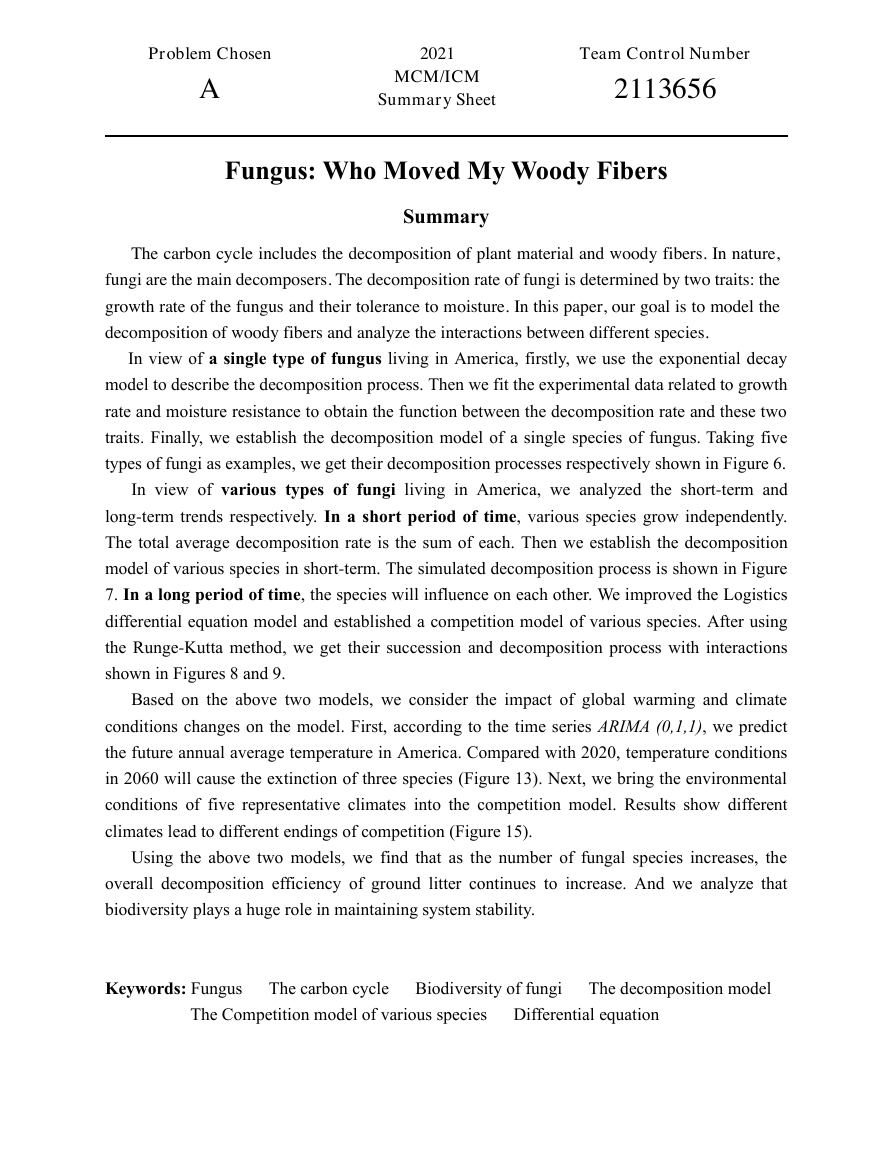
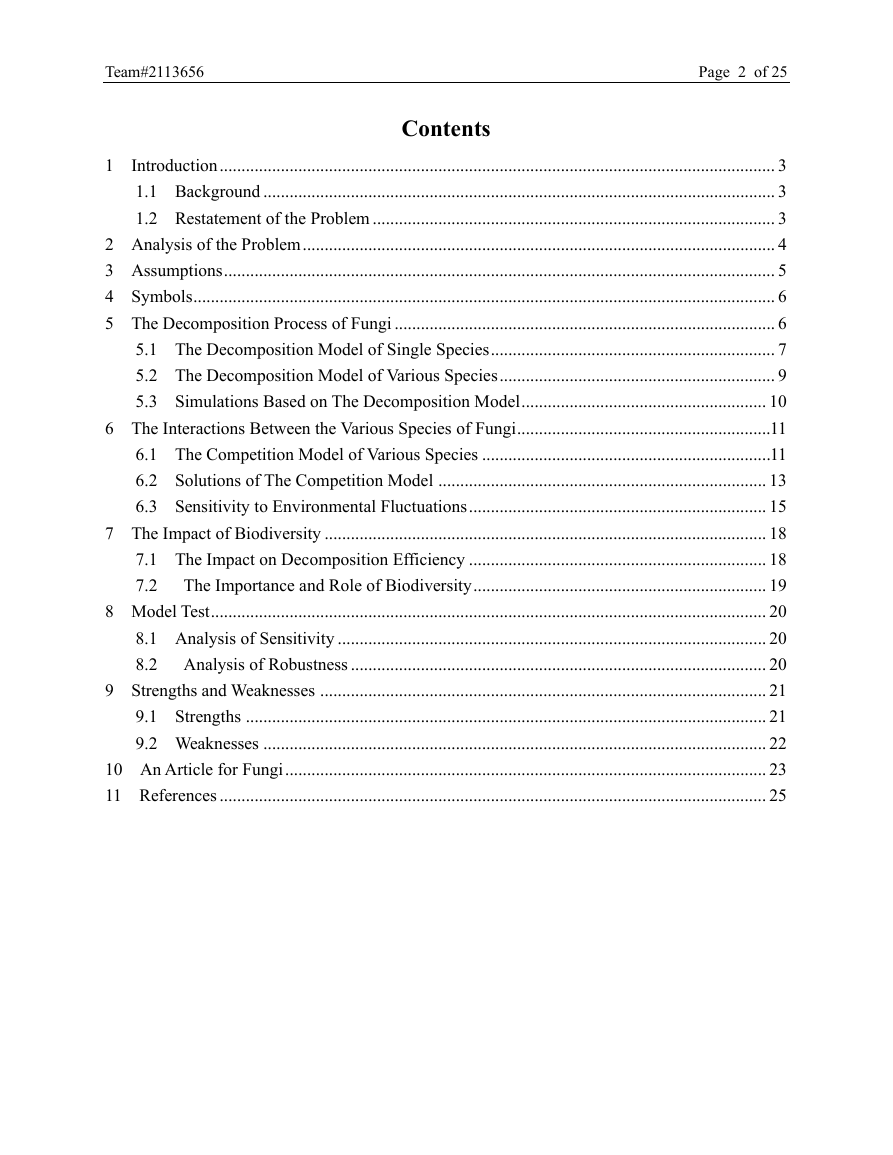

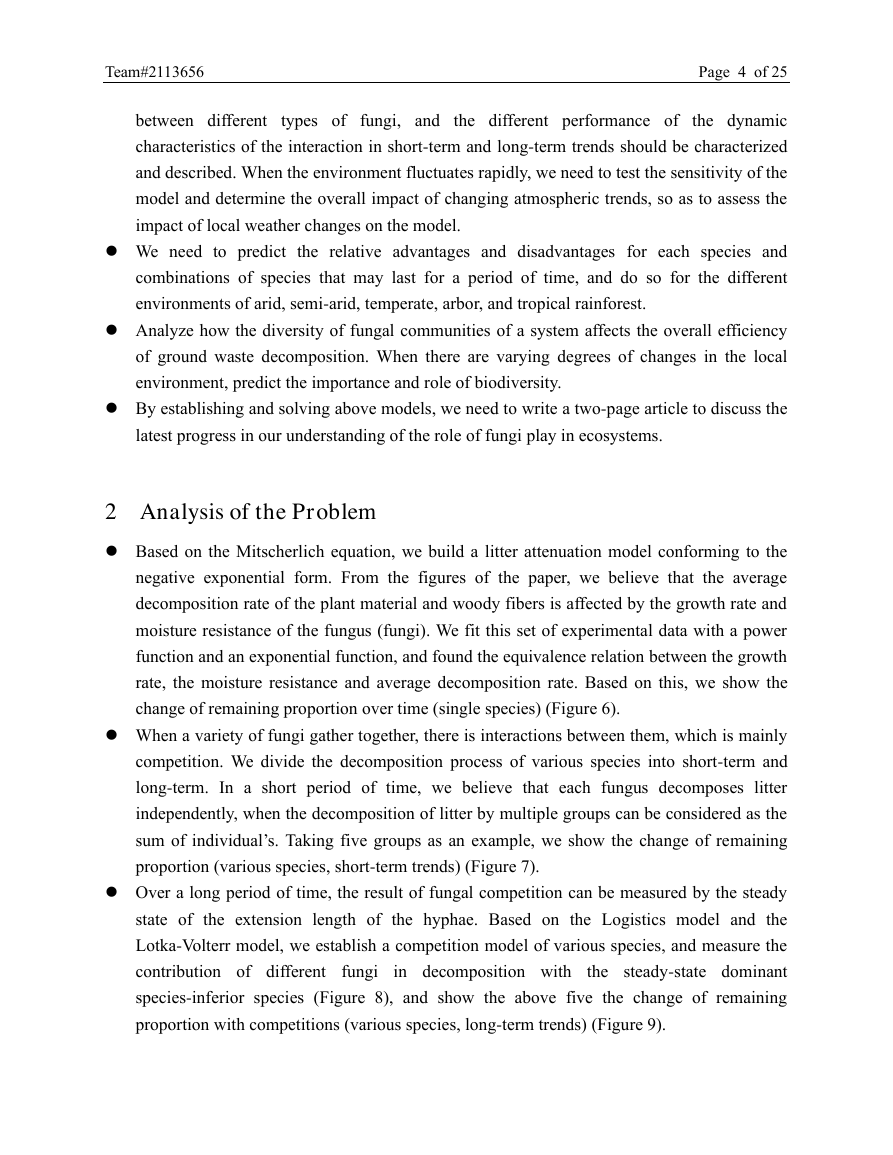

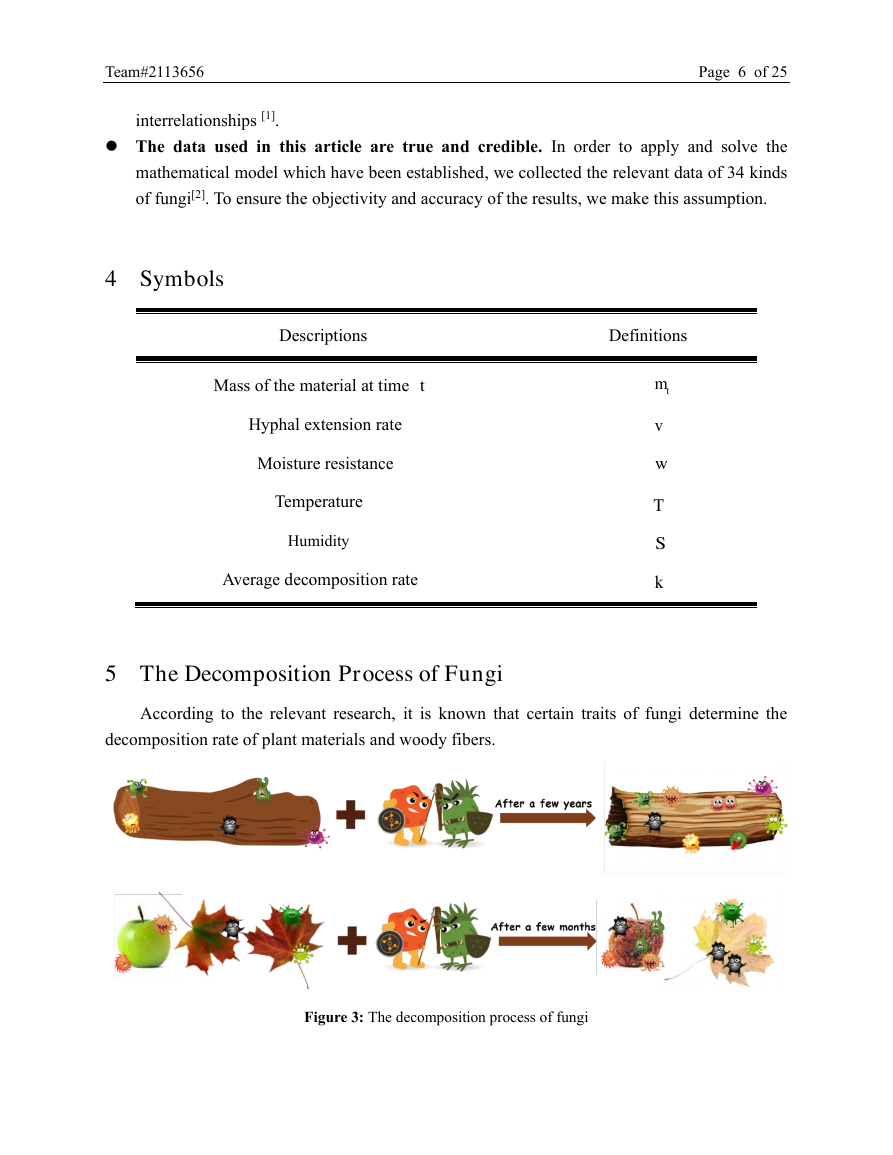
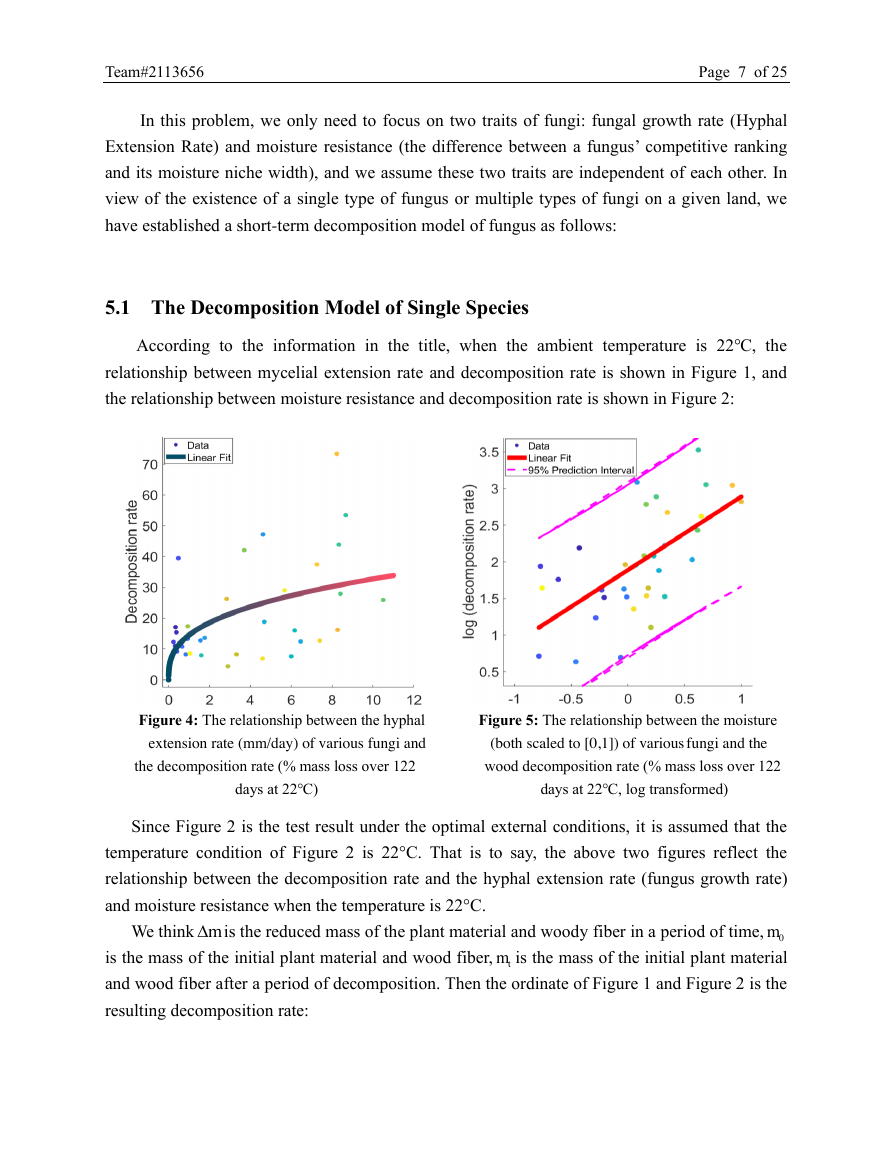









 2023年江西萍乡中考道德与法治真题及答案.doc
2023年江西萍乡中考道德与法治真题及答案.doc 2012年重庆南川中考生物真题及答案.doc
2012年重庆南川中考生物真题及答案.doc 2013年江西师范大学地理学综合及文艺理论基础考研真题.doc
2013年江西师范大学地理学综合及文艺理论基础考研真题.doc 2020年四川甘孜小升初语文真题及答案I卷.doc
2020年四川甘孜小升初语文真题及答案I卷.doc 2020年注册岩土工程师专业基础考试真题及答案.doc
2020年注册岩土工程师专业基础考试真题及答案.doc 2023-2024学年福建省厦门市九年级上学期数学月考试题及答案.doc
2023-2024学年福建省厦门市九年级上学期数学月考试题及答案.doc 2021-2022学年辽宁省沈阳市大东区九年级上学期语文期末试题及答案.doc
2021-2022学年辽宁省沈阳市大东区九年级上学期语文期末试题及答案.doc 2022-2023学年北京东城区初三第一学期物理期末试卷及答案.doc
2022-2023学年北京东城区初三第一学期物理期末试卷及答案.doc 2018上半年江西教师资格初中地理学科知识与教学能力真题及答案.doc
2018上半年江西教师资格初中地理学科知识与教学能力真题及答案.doc 2012年河北国家公务员申论考试真题及答案-省级.doc
2012年河北国家公务员申论考试真题及答案-省级.doc 2020-2021学年江苏省扬州市江都区邵樊片九年级上学期数学第一次质量检测试题及答案.doc
2020-2021学年江苏省扬州市江都区邵樊片九年级上学期数学第一次质量检测试题及答案.doc 2022下半年黑龙江教师资格证中学综合素质真题及答案.doc
2022下半年黑龙江教师资格证中学综合素质真题及答案.doc